Key takeaways:
- Pro-life advocacy emphasizes the sanctity of life and the importance of storytelling to convey personal experiences that resonate with others.
- Identifying and understanding your audience is crucial for effective advocacy, allowing for tailored narratives that connect on a personal level.
- Preparing for legislative meetings involves thorough research, crafting a logical flow of talking points, and utilizing personal stories to enhance your message.
- Follow-up communication after meetings, whether through notes or invitations to events, is key to maintaining relationships and reinforcing advocacy efforts.
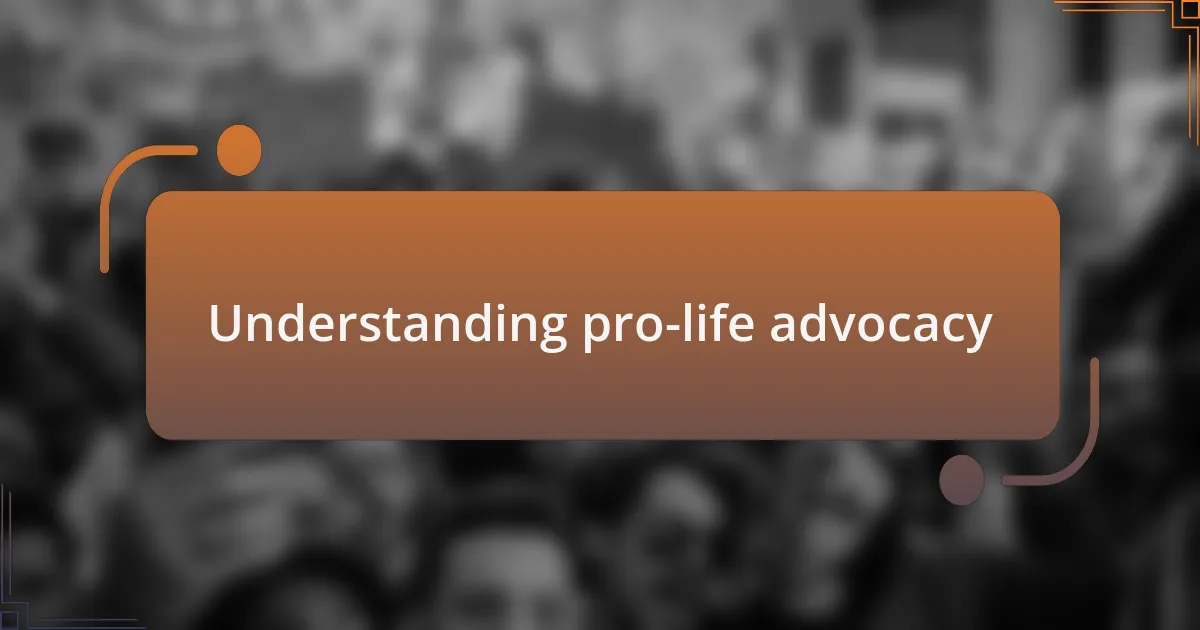
Understanding pro-life advocacy
Pro-life advocacy is rooted in a profound belief in the sanctity of human life at all stages, from conception to natural death. I’ve found that this perspective isn’t just a philosophical stance; it’s an emotional journey for many individuals. For instance, I remember speaking with a mother who shared her heart-wrenching experience of choosing to carry her child despite receiving a terminal diagnosis. Her strength and conviction illuminated the struggles so many face in this movement.
When I reflect on this topic, I often ask myself: how can we effectively communicate the value of life to those who may not share our views? For me, it starts with storytelling. Each shared experience, like that of the mother I spoke to, adds a personal layer to the advocacy. It transforms abstract principles into relatable narratives that resonate with people on a deeper level.
As I immerse myself in pro-life advocacy, I notice that it also encompasses a significant aspect of support for women facing unexpected pregnancies. I recall a conversation with a young woman who felt overwhelmed by her situation. By offering her compassionate support, I saw how pro-life advocacy extends beyond just opposing abortion; it emphasizes empowerment, options, and understanding in life’s most challenging moments.
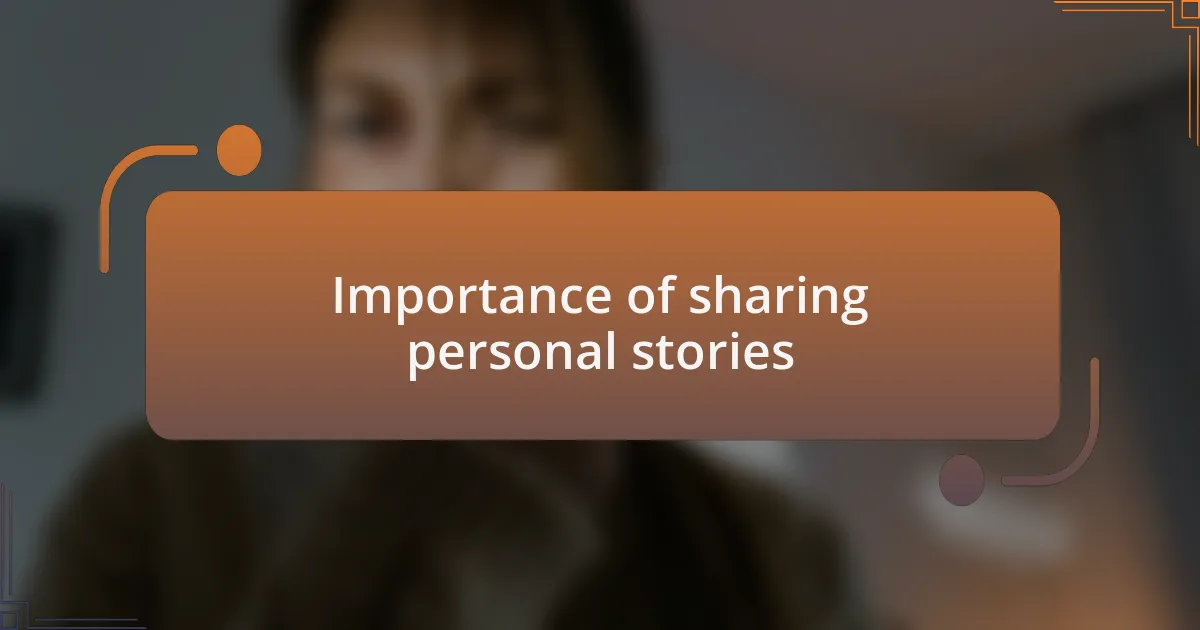
Importance of sharing personal stories
Sharing personal stories is paramount in pro-life advocacy because they humanize the statistics and arguments often presented. I remember a moment during a lobbying event when I recounted my own unexpected pregnancy. The room shifted; the energy connected us all. People who might have otherwise remained indifferent began to see the reality of the choices we face.
Stories evoke emotions and forge connections. For instance, I once met a legislator who was moved by a testimony of a father who chose life for his child with disabilities. That moment resonated deeply, prompting him to reconsider his perspectives on legislation affecting vulnerable lives. It reinforced my belief that sharing our experiences isn’t just about making a statement; it’s about inviting empathy and understanding.
Through personal storytelling, we can bridge the gap between opposing viewpoints and ignite conversations that matter. Have you ever felt the power of a story? When I shared my experience with others, I realized how one narrative could spark curiosity and inspire someone to learn more. It’s these heartfelt accounts that can shift opinions and ultimately lead to change in legislation and societal attitudes regarding life.
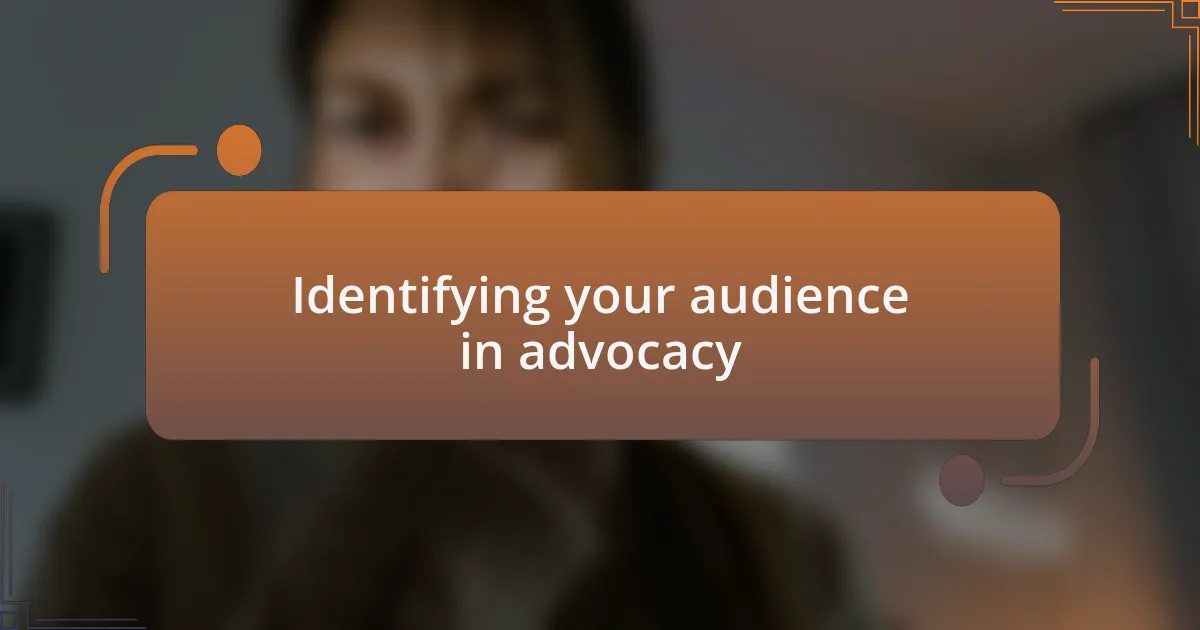
Identifying your audience in advocacy
Identifying your audience in advocacy is a crucial step in crafting your message. I recall attending a community town hall where many attendees were uncertain about their positions on pro-life issues. By observing their responses, I learned that personal stories resonate differently with those who have experienced similar situations. It’s essential to tailor your narrative to connect with those who might be on the fence, as they can be swayed by relatable experiences.
Understanding who you’re speaking to also shapes how we present our stories. When I shared my journey with college students, we focused on the challenges of unexpected pregnancies. The language and emotions I used were more casual and direct, which helped demystify the topic and encouraged genuine dialogue. It made me realize that our audience deserves authenticity—just as they want to hear a truth that feels relevant and impactful to them.
Have you ever found yourself wondering how to reach someone who seems miles away from your perspective? I once struggled with this when talking to a legislator who represented a very different constituency. By highlighting local stories that represented the diverse voices in the community, I was able to bridge that gap. It reminded me that every story must reflect the audience’s values to truly resonate and enact change.
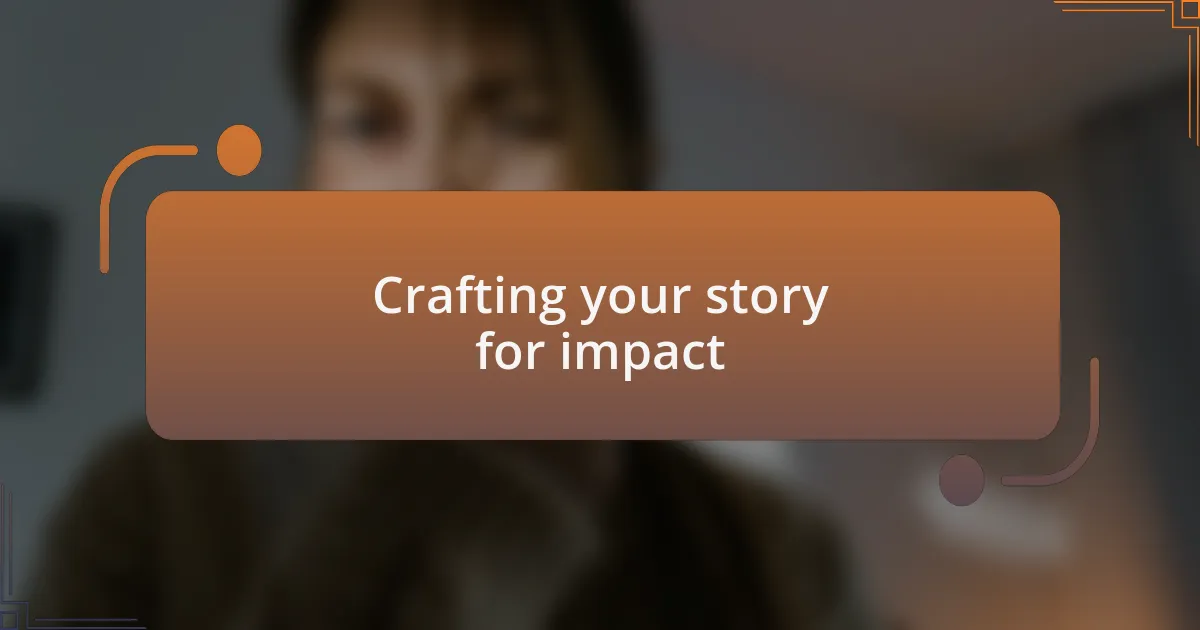
Crafting your story for impact
Crafting a compelling narrative is all about emotion and authenticity. I remember a time when I shared my experience at a legislative hearing. I spoke from the heart about the joy and fear surrounding my unexpected pregnancy. It was incredible to see how my vulnerability resonated with lawmakers, making the discussion feel less like a political debate and more like a shared human experience. When we speak truthfully about our lives, we often touch the very essence of what our listeners need to hear.
In another instance, I tailored my story to address specific legislation affecting women’s health. By painting a vivid picture of the implications these laws had on families, I could draw a direct line between policy and personal lives. Have you ever thought about how the smallest details can make your message more relatable? Describing my own challenges with access to healthcare brought the issues to life in a way statistics simply couldn’t. It reminded me that personal anecdotes are essential—they can transform abstract concepts into relatable realities.
To create impact, consider how the structure of your story influences the audience’s perception. I once structured my testimony to build suspense, revealing personal challenges gradually. This approach kept listeners engaged, allowing each detail to deepen their emotional investment. It reinforces an important lesson: a well-crafted story isn’t just about what you say but how you say it. What does your journey look like, and how can it inspire someone else?
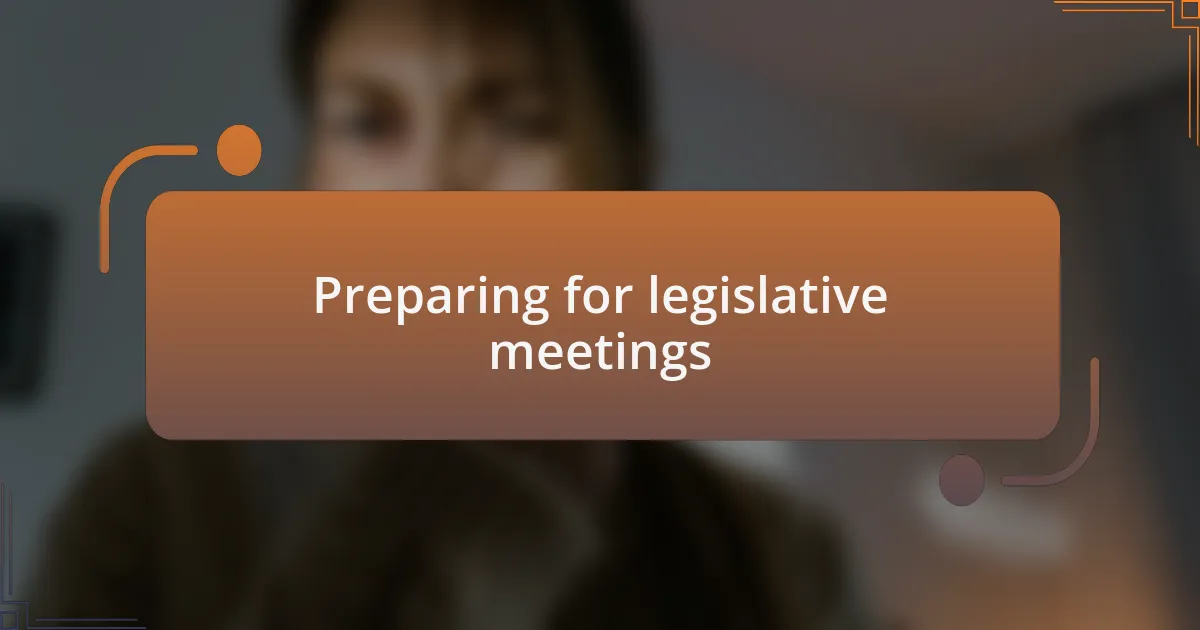
Preparing for legislative meetings
Preparing for legislative meetings can feel daunting, but it’s essential to enter these spaces equipped with clarity and purpose. I recall preparing for a meeting where I spent hours researching not only the legislators’ backgrounds but also the specific policies on the agenda. This preparation gave me the confidence to articulate my concerns effectively while also allowing me to anticipate questions and objections, ensuring I was ready to engage in meaningful dialogue.
One of the most crucial steps I took was creating an outline of my key points. This isn’t just about what you want to say; it’s about ensuring your story flows logically and resonates. I practiced delivering my points out loud, which helped me refine my message and maintain eye contact during the meeting, creating a connection that statistics alone could not achieve. How do you think your delivery affects the way your story is received?
Bringing along relevant materials, such as pamphlets or personal letters from those affected by the legislation, can bolster your message. I once brought a letter from a friend who faced challenges under existing laws, and the emotional weight of their words complemented my own narrative beautifully. It’s this kind of collaboration that can amplify voices and reinforce the importance of our shared stories in legislative discussions. How can you utilize the experiences of those around you to strengthen your presence in these meetings?
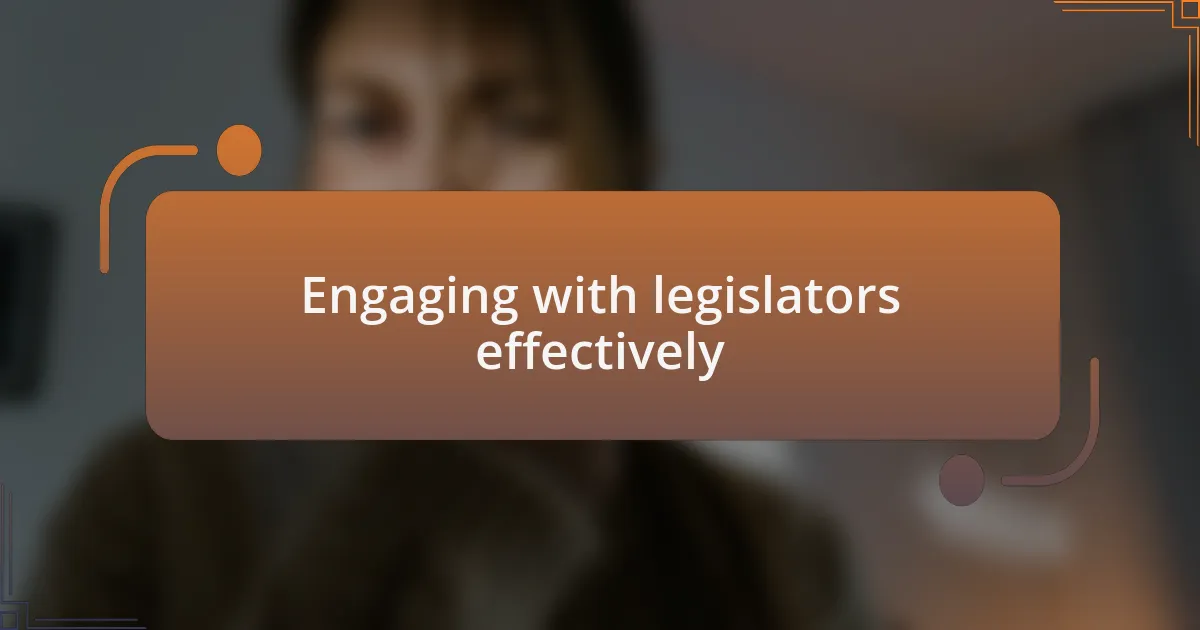
Engaging with legislators effectively
When engaging with legislators, authenticity is key. I remember a time when I shared a heartfelt story about a friend who struggled with an unexpected pregnancy. That moment of vulnerability broke through the usual formalities and reminded the legislator that there are real lives behind the policies. How does sharing your own experiences shape the way others perceive the issues at hand?
Listening actively during meetings is just as important as speaking. In one of my meetings, I noticed how the legislator nodded thoughtfully as I recounted my experiences. This non-verbal communication indicated that my story resonated with him, making me feel more connected to the discussion. Have you ever considered how much impact a simple moment of connection can have on your advocacy efforts?
Follow-up communication can significantly solidify the relationship you build during these meetings. After one particularly impactful conversation, I sent a personalized thank-you note reiterating our discussion and providing additional resources. This small gesture opened up a dialogue that continued well beyond our initial meeting, reinforcing the importance of maintaining those connections. How can a follow-up letter or email enhance the impact of your advocacy?
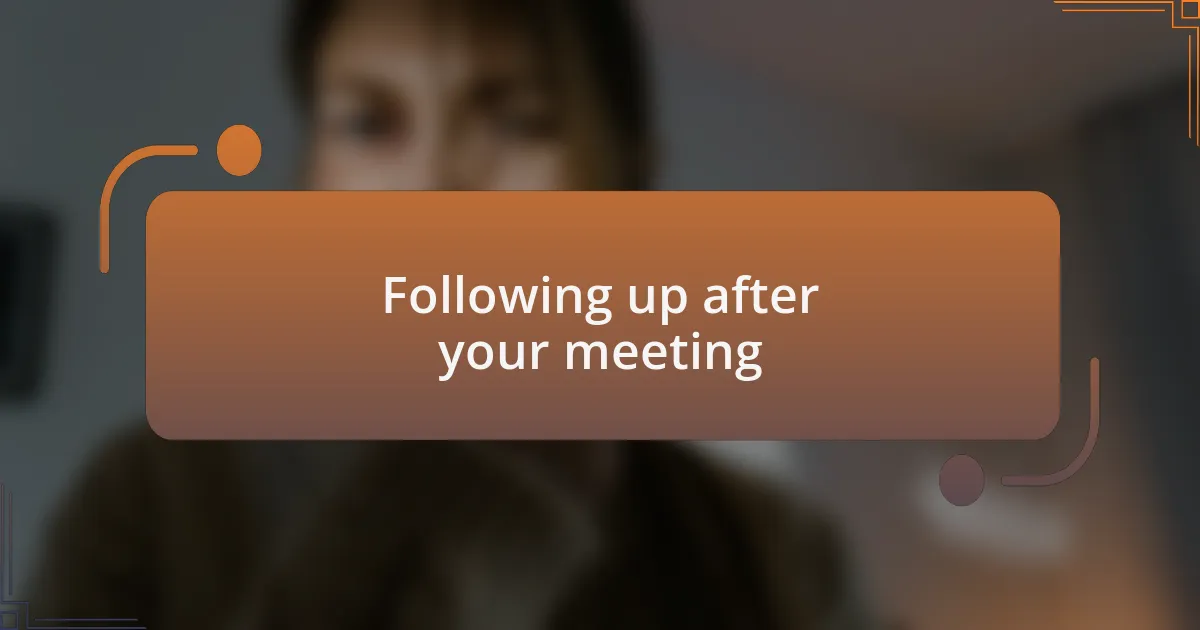
Following up after your meeting
After your meeting, taking a moment to send a follow-up note can deepen your impact. I once reached out to a legislator with a brief email, highlighting a key point we discussed and offering additional resources. The response was quick and positive, showing me that my initiative made a difference. Have you considered how a simple gesture can keep the conversation alive?
Sometimes, a phone call can also work wonders. I recall calling a legislator a week after our meeting to share a personal story related to the topic we discussed. It created a more personal connection and demonstrated my commitment to advocacy. How can you leverage your voice to reinforce the importance of your message?
Don’t underestimate the power of inviting them to community events related to the issue. I remember inviting a legislator to a pro-life rally that underscored the need for advocacy in our community. When they attended, it not only solidified our relationship but also validated the cause with their presence. What ways could you creatively engage them beyond the meeting room?